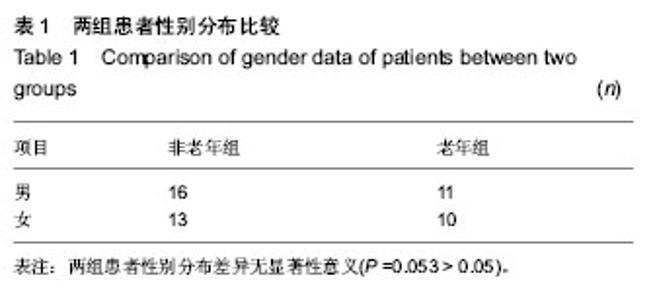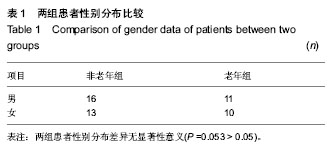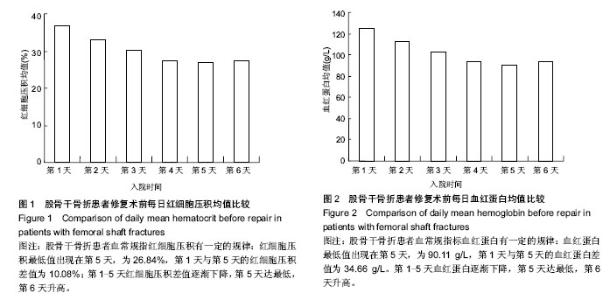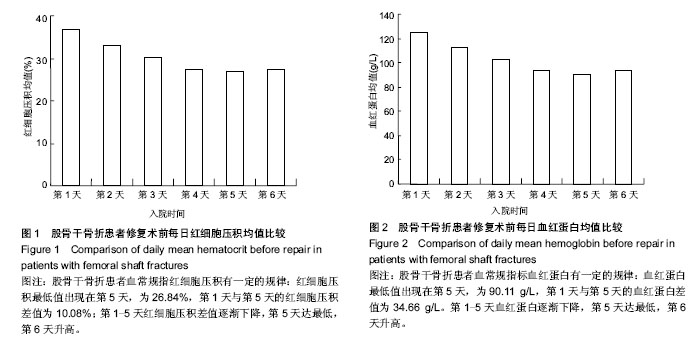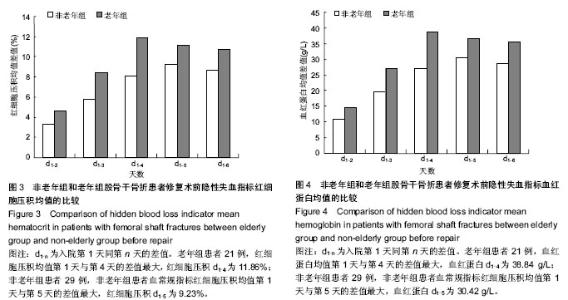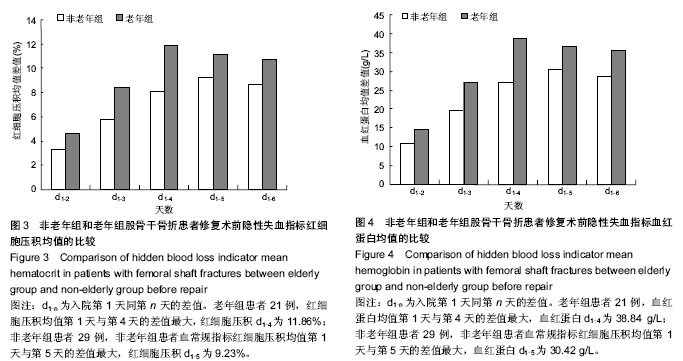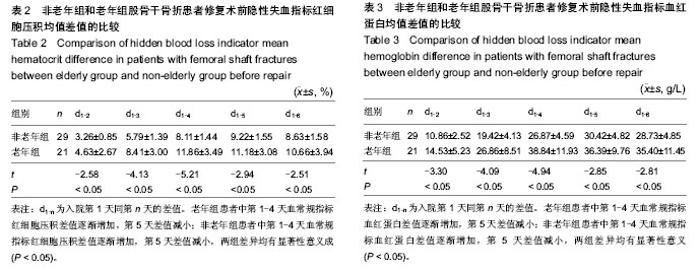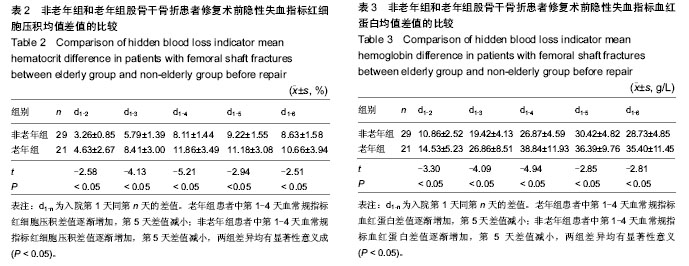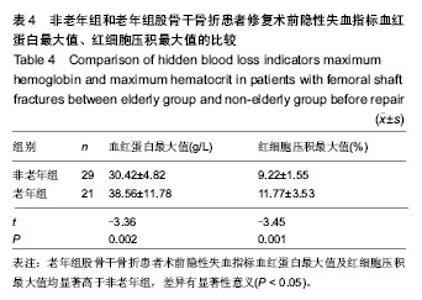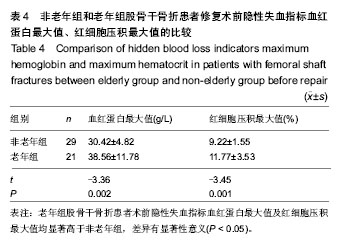| [1] Shen HL,Li Z,Feng ML, et al. Analysis on hidden blood loss of total knee arthroplasty in treating knee osteoarthritis. Chin Med J.2011;11: 1653 -1656.
[2] Prasad N,Padmanabhan V,Mullaji A. Blood loss in total knee arthroplasty:an analysis of risk factors. Int Orthop. 2007;31: 39-44.
[3] 胥少汀,葛宝丰,徐印坎.实用骨科学[M]. 3版.北京:人民军医出版社,2006: 724.
[4] 吴在德,吴肇汉.外科学[M]. 7版.北京:人民卫生出版社,2008: 723.
[5] Holte K, Sharrock NE, Kchlet H. Pathophysiology and clinical implications of perioerative fluid excess. Br J Anaesth. 2002; 89(4):622-632.
[6] Gross JB.Estimating allowable blood loss:corrected for dilution. Anesthesiology. 1983;58(3):277-280.
[7] 孙然,程家祥,陈伟,等.股骨干骨折的类型、性别及年龄特点[J].中华创伤骨科杂志, 2014,16(3):238-241.
[8] Burge R, Dawson-Hughes B, Solomon DH, et al. Incidence and economic burden of osteoporosis-related fractures in the United States, 2005-2025. J Bone Miner Res. 2007; 22(3): 465-475.
[9] Napoli N,Schwartz AV,Palermo L,et al.Risk factors for subtrochanteric and diaphyseal fractures: the study of osteoporotic fractures.J Clin Endocrinol Metab. 2013;98(2): 659-667.
[10] Scannell BP, Waldrop NE,Sasser HC,et al. Skeletal traction versus external fixation in the initial temporization of femoral shaft fractures in severely injured patients.J Trauma. 2010; 68(3):633-640.
[11] 李青,邓进,郑昆.外固定架在严重多发伤并股骨干骨折中的应用[J].中华急诊医学杂志,2005,14(2):106-107.
[12] 付鹏军.锁定加压接骨板内固定治疗股骨远端骨折16例[J]. 郑州大学学报(医学版), 2008,43(3):617-619.
[13] 王光林,吴刚,杨天府,等.股骨远端复杂类型骨折微侵袭治疗的疗效分析[J].中华创伤杂志, 2008,24(9):715-771.
[14] Alemdaroglu KB,Tiftikci U,Iltar S. Factors affecting the fracture healing in treatment of tibial shaft fractures with circular external fixator. Injury. 2009;40(11):1151-1156.
[15] Esteve-Balzola C, García-Forcada IL, Calbet-Vidal JM. Femoral Shaft Fractures Treated by Intramedullary Interlocked Nailing. Revista Espa(n)ola de Cirugía Ortopédicay Traumatología (English Edition). 2007:335-342.
[16] 徐伟,杨国栋,张相弟,等.改良牵引床在股骨干骨折闭合复位髓内钉内固定术中的应用[J].中国骨与关节损伤杂志, 2014, 29(6): 76-77.
[17] 徐小东,姜保国,张殿英,等.骨科手术隐性失血的研究进展[J].伤害医学(电子版), 2013,(3):37-42.
[18] 张越,孙天胜,姚红,等.Dynesys system技术以及PLIF技术治疗腰椎间盘突出症隐性失血的临床分析[J].中国矫形外科杂志, 2014, 22(1):32-35.
[19] Sehat KR,Evans R,Newman JH.How much blood is lost in total knee arthroplasty.Correct blood loss management should take hidden loss into account.Knee. 2000;(7):151-155.
[20] Pattison E,Protheroe K,Pringle RM. Reduction in haemoglobin after knee joint surgery.Ann Rheum Dis. 1973;32(06):582-584.
[21] Erskine JG, Fraser C, Simpson R, et al. Blood loss with knee joint replacement. J R Coll Surg Edinb. 1981;26(5):295-297.
[22] Smith GH, Tsang J, Molyneux SG, et al.The hidden blood loss after hip fracture. Injury. 2011;42(2):133-135.
[23] 张占岭,武志伟.隐性失血对股骨转子间骨折手术疗效的影响[J].河南医学研究, 2011,20(4):428-430.
[24] 郑杰,高迪,贾斌,等.老年全髋置换患者术后隐性出血与生存质量关系的对照研究[J].中国中医急症,2013,22(7):1135-1135,1182.
[25] 金惠铭,王建枝.病理生理学[M]. 7版.北京:人民卫生出版社, 2006: 178.
[26] 朱宝林,王洪俊,谭诗平.股骨近端骨折围手术期隐性失血量的研究[J].中国实用医药,2009,4(11):27-29.
[27] 高福强,,李子剑,张克,等.人工关节置换术后隐性失血计算方法的初步探析[J].中华外科杂志,2011,49(12):1144-1147.
[28] 丛宇.人工关节置换术后失血的相关研究[J].医学研究生学报, 2010,23(12):1332-1336.
[29] 覃健,余存泰,徐中和.全髋关节及全膝关节置换术后隐性失血的临床影响[J].中华骨科杂志,2006,26(5):323-326.
[30] 刘宾宾.慢性失血对凝血纤溶系统中t-PA含量的影响[D].太原:山西医科大学,2010. |
